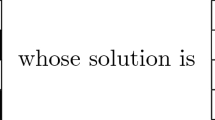Abstract
This paper considers a nonconvex geometric optimization problem with two-sided joint probabilistic constraints, namely rectangular constraints. We transform the stochastic problem into a deterministic one. Further, we use a logarithmic transformation combined with the arithmetic–geometric mean inequality to obtain a biconvex problem. Based on the biconvex structure of the obtained program and the corresponding partial KKT system, we propose a dynamical neural network to solve the initial rectangular problem. The main feature of our framework is to propose a converging method to solve rectangular joint chance-constrained optimization problems without the use of any convex approximation unlike the state-of-the-art solving methods. To illustrate the performances of our approach, we conducted several tests on a minimum transport cost problem and a shape optimization problem.






Similar content being viewed by others
Data availability
All data generated or analyzed during this study are included in this published article and are also available from the corresponding author on reasonable request.
References
Charnes, A., Cooper, W.W.: Chance-constrained programming. Manage. Sci. 6(1), 73–79 (1959). https://doi.org/10.1287/mnsc.6.1.73
Perlumutter, D.D.: Geometric programming-theory and application. AIChE J. 13(4), 829–830 (1967). https://doi.org/10.1002/aic.690130408
Hoburg, W., Abbeel, P.: Geometric programming for aircraft design optimization. AIAA J. 52(11), 2414–2426 (2012). https://doi.org/10.2514/6.2012-1680
Chiang, M.: Geometric programming for communication systems. Found. Trends® Commun. Inf. Theory 2(1–2), 1–154 (2005). https://doi.org/10.1561/0100000005
Chiang, M., Tan, C.W., Palomar, D.P., O’neil, D., Julian, D.: Power control by geometric programming. IEEE Trans. Wirel. Commun. 6(7), 2640–2651 (2007). https://doi.org/10.1109/TWC.2007.05960
Boyd, S.P., Kim, S., Patil, D., Horowitz, M.: Digital circuit optimization via geometric programming. Oper. Res. 53(6), 899–932 (2005). https://doi.org/10.1287/opre.1050.0254
Liu, C.-S., Xu, G., Wang, L.: An improved geometric programming approach for optimization of biochemical systems. J. Appl. Math. (2014). https://doi.org/10.1155/2014/719496
Vanderhaegen, J.P., Brodersen, R.W.: Automated design of operational transconductance amplifiers using reversed geometric programming. In: Proceedings of the 41st Annual Design Automation Conference. DAC ’04, pp. 133–138. Association for Computing Machinery, New York, NY, USA (2004). https://doi.org/10.1145/996566.996608
Dupačová, J.: Stochastic geometric programming with an application. Kybernetika 46(3), 374–386 (2010)
Liu, J., Lisser, A., Chen, Z.: Stochastic geometric optimization with joint probabilistic constraints. Oper. Res. Lett. 44(5), 687–691 (2016). https://doi.org/10.1016/j.orl.2016.08.002
Liu, J., Peng, S., Lisser, A., Chen, Z.: Rectangular chance constrained geometric optimization. Optim. Eng. 21(2), 537–566 (2019). https://doi.org/10.1007/s11081-019-09460-3
Xu, G.: Global optimization of signomial geometric programming problems. Eur. J. Oper. Res. 233(3), 500–510 (2014). https://doi.org/10.1016/j.ejor.2013.10.016
Faybusovich, L.: Dynamical systems which solve optimization problems with linear constraints. IMA J. Math. Control Inf. 8(2), 135–149 (1991). https://doi.org/10.1093/imamci/8.2.135
Schropp, J., Singer, I.: A dynamical systems approach to constrained minimization. Numer. Funct. Anal. Optim. 21(3–4), 537–551 (2000). https://doi.org/10.1080/01630560008816971
Aluffi-Pentini, F., Parisi, V., Zirilli, F.: Global optimization and stochastic differential equations. J. Optim. Theory Appl. 47(1), 1–16 (1985). https://doi.org/10.1007/bf00941312
Effati, S., Nazemi, A.R.: Neural network models and its application for solving linear and quadratic programming problems. Appl. Math. Comput. 172(1), 305–331 (2006). https://doi.org/10.1016/j.amc.2005.02.005
Cheng, J., Lisser, A.: A second-order cone programming approach for linear programs with joint probabilistic constraints. Oper. Res. Lett. 40(5), 325–328 (2012). https://doi.org/10.1016/j.orl.2012.06.008
Adasme, P., Lisser, A.: A stochastic geometric programming approach for power allocation in wireless networks. Wirel. Netw. (2023). https://doi.org/10.1007/s11276-023-03295-8
Jiang, M., Meng, Z., Shen, R.: Partial exactness for the penalty function of biconvex programming. Entropy (2021). https://doi.org/10.3390/e23020132
Gorski, J., Pfeuffer, F., Klamroth, K.: Biconvex sets and optimization with biconvex functions: a survey and extensions. Math. Methods Oper. Res. 66(3), 373–407 (2007). https://doi.org/10.1007/s00186-007-0161-1
Foias, C., Frazho, A.E.: Positive definite block matrices. Commut. Lift. Approach Interpolat. Prob. (1990). https://doi.org/10.1007/978-3-0348-7712-1_16
Rockafellar, R.T., Wets, R.J.-B.: Variational Analysis. Springer, Berlin (1998). https://doi.org/10.1007/978-3-642-02431-3
Rao, S.S.: 8 Geometric Programming, pp. 492–543. Wiley, New Jersey (2009). https://doi.org/10.1002/9780470549124.ch8
Author information
Authors and Affiliations
Corresponding author
Additional information
Publisher's Note
Springer Nature remains neutral with regard to jurisdictional claims in published maps and institutional affiliations.
Rights and permissions
Springer Nature or its licensor (e.g. a society or other partner) holds exclusive rights to this article under a publishing agreement with the author(s) or other rightsholder(s); author self-archiving of the accepted manuscript version of this article is solely governed by the terms of such publishing agreement and applicable law.
About this article
Cite this article
Tassouli, S., Lisser, A. A neurodynamic approach for joint chance constrained rectangular geometric optimization. Optim Lett (2023). https://doi.org/10.1007/s11590-023-02050-4
Received:
Accepted:
Published:
DOI: https://doi.org/10.1007/s11590-023-02050-4




